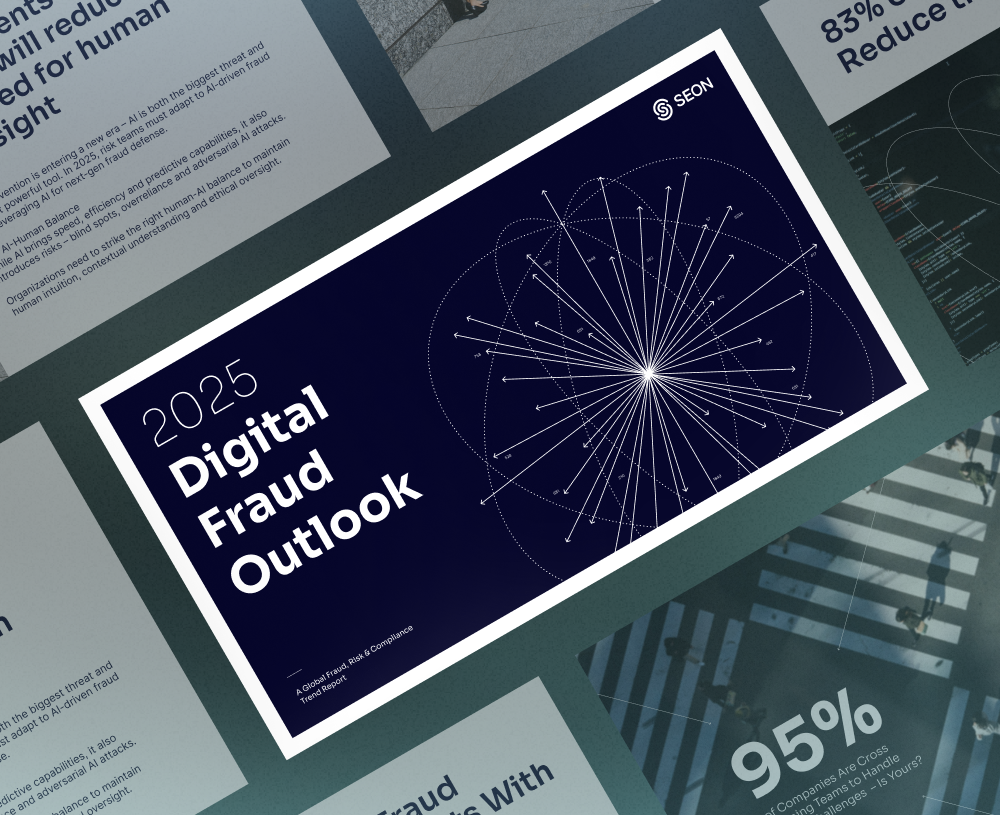Fraud is expected to increase and evolve in complexity in 2025, fueled by advanced technologies like AI and Fraud-as-a-Service (FaaS). Insights from industry surveys reveal emerging fraud trends, major prevention challenges, and strategies for implementing AI-driven anti-fraud solutions. Future fraud prevention will hinge on effectively combining machine learning with human oversight to ensure secure, real-time detection and heightened protection.
What Is Fraud Detection?
Fraud detection is the process of identifying suspicious or unauthorized activity that could indicate fraudulent behavior, especially in online transactions and digital interactions. It helps businesses prevent financial loss, data breaches, and reputational damage by using specialized software, RiskOps tools, and fraud analysts to monitor transactions, user behavior, and applications in real time.
A strong fraud detection strategy combines automated systems with human oversight. It includes setting clear risk policies, training staff to recognize fraud signals, and staying compliant with regulations like AML, CDD, and GDPR. Regular system updates and audits ensure detection methods remain effective as fraud tactics evolve.
Why Is Modern Fraud Detection Important
Fraud detection is essential for any online business, especially today when cyber threats are more sophisticated and widespread. With the growth of ecommerce and digital transactions, effective fraud prevention strategies have become crucial.
Fraud can appear in many forms and affect businesses across all sectors. A 2024 PwC study found that over 60% of organizations experienced fraud-related financial losses, with nearly 30% reporting losses of over $1 million. Additionally, 25% said fraud disrupted their operations, and 20% noted a drop in employee morale. As fraud evolves—with hackers accounting for 32% of incidents and customers for 28%—traditional detection methods may no longer be enough, making real-time technologies essential to counter increasingly sophisticated threats.
Fraud has evolved—legacy tools like 2FA and device checks fall short. Discover how modern fraud detection keeps your business protected.
Learn here
What Are the Common Types of Fraud?
Fraud takes on many forms, and it adapts to every business model. However, there are a few recurrent attack vectors worth knowing about. These include:
- Credit card fraud: Criminals steal credit card numbers and use them to buy services or products from your company. A chargeback is then submitted, for which you must cover the administrative fees.
- Account takeover fraud: more sophisticated attacks, which use identity theft (often through phishing) to steal credentials of an existing account. The end goal, however, is still the same: steal money or personal data from the original user.
- Fake accounts: Fraudsters falsify information or use stolen IDs to create a new account. A lax signup policy may allow easier onboarding for traction, but it also opens the door to bad agents. It’s one area we’ve seen a boom during the pandemic – for example in the FX trading world.
- Bonus abuse: Fraudsters use linked accounts to abuse merchant terms, whether it is to benefit from signup promotions or loyalty rewards.
- Friendly fraud: This fraud happens when the legitimate cardholder contests a payment. This is either because they forgot, regret their purchase, or maliciously anticipated a chargeback request.
- Affiliate fraud: A marketing partnership can quickly turn sour if your affiliates send bad traffic to your site on purpose. This is particularly prevalent in the iGaming industry, where unscrupulous affiliate fraudsters target PPC (pay-per-click) and PPL (pay-per-lead) acquisition models.
- Return fraud: Another attack vector, growing in popularity due to changing return policies across the ecommerce landscape. Fraudsters purchase items on your site and take advantage of your return policy to get free items, or intentionally deplete your inventory.
Evaluating the Complete Impact of Fraud Costs
In today’s interconnected digital landscape, fraud has become an urgent and complex challenge that impacts multiple business functions, extending beyond legal and compliance to include areas like marketing and customer experience. Global fraud costs have soared to $5.13 trillion annually, with advanced technologies like AI enabling fraudsters to exploit digital vulnerabilities, while indirect effects—such as operational inefficiencies, customer churn, and compliance costs—intensify fraud’s financial impact. As businesses scale, the need for integrated, AI-powered fraud prevention solutions becomes essential to mitigate fraud’s total cost, protect customer trust, and support sustainable growth.
Discover fraud’s hidden costs and its impact on growth, efficiency, and trust.
Learn more here
The Best Fraud Detection and Prevention Methods
Fraud detection and prevention requires a three-pronged approach, combining education about fraud risks, anti-fraud technology and an elaborate risk strategy.
- Education and Awareness: Educating employees and customers on fraud risks is crucial. Awareness can significantly reduce account takeover incidents, phishing, social engineering, and CEO fraud by teaching your staff how to recognize suspicious activities.
- Anti-Fraud Features and Transaction Monitoring: A robust anti-fraud strategy involves detailed user fingerprinting through digital footprinting, social media lookups, device fingerprinting, and AML checks to identify risky users. Adding transaction monitoring enriches this approach by analyzing real-time payment data, utilizing tools like card BIN lookups to validate credit card details and identify high-risk transactions. This comprehensive data use helps spot discrepancies and prevent fraud at the payment stage.
- Rules Creation and Machine Learning: Implementing custom risk rules and fraud scores is essential for adapting to evolving fraud patterns. Machine learning enhances this by analyzing large volumes of data to uncover patterns and suggest risk rules, improving detection accuracy and efficiency over time. Combining rule-based systems with machine learning allows for the dynamic and effective prevention of complex fraud attacks.
Main Challenges of Fraud Detection and Prevention
Fraud is an unavoidable risk when conducting business online. However, understanding the core challenges of fraud detection and fraud prevention allows companies to develop effective strategies that not only reduce risk but also ensure compliance with evolving regulatory standards.
Key Challenges in Fraud Detection
Fraud detection involves identifying suspicious activities and fraudulent behaviors before they cause damage. It’s the first line of defense in your anti-fraud strategy, but it presents unique challenges:
- False Positives and Customer Friction: One of the most pressing issues in fraud detection is avoiding excessive false positives. When legitimate customers are mistakenly flagged as fraudsters, it leads to poor user experiences and abandoned checkouts. Balancing detection sensitivity with customer convenience is crucial.
- Evolving Fraud Tactics: Fraudsters constantly change their techniques. This means businesses must continuously update their fraud detection systems to recognize new attack patterns, stay ahead of criminal tactics, and comply with regional regulations to avoid reputational and financial penalties.
- Data Quality and Accuracy: Modern fraud detection systems rely heavily on machine learning and data analysis. Poor-quality or mislabeled data undermines the ability of AI models to identify high-risk behaviors, making data hygiene essential for maintaining detection accuracy.
- Maintaining Real-Time Monitoring: Detecting fraud in real time is critical for minimizing damage, especially in fast-moving environments like eCommerce, fintech, or digital banking. Systems must process vast amounts of data and deliver actionable insights instantly.
Developing the Best Fraud Prevention Framework
Once threats are detected, fraud prevention comes into play. Prevention strategies aim to stop fraud from occurring altogether by putting proactive measures and safeguards in place.
Key elements of a strong fraud prevention strategy include:
- Selecting the Right Tools: Choose fraud prevention software that aligns with your risk profile. Look for features like digital ID verification, device fingerprinting, behavioral analytics, and multi-channel coverage. Real-time decisioning and compliance support (e.g., AML, GDPR, CDD) are also essential.
- Establishing a Skilled Fraud Team: In regulated industries, building a dedicated fraud prevention team is non-negotiable. This includes hiring specialists and legally mandated roles such as a Money Laundering Reporting Officer (MLRO).
- Training and Threat Awareness: Prevention isn’t just about software. Human vigilance matters. Educate employees on risks like Business Email Compromise (BEC) and Authorized Push Payment (APP) fraud to help them recognize phishing attempts and social engineering schemes.
- Defining Risk Appetite and Workflows: Set clear boundaries on how much fraud-related risk your business is willing to tolerate. Create documented procedures for handling fraud events, from internal response protocols to reporting requirements. A well-prepared team can act swiftly without panic when incidents occur.
Implementation and Continuous Optimization
Deploying fraud detection and prevention systems is only the beginning. Continuous improvement ensures your protections remain robust:
- Regular Fraud Audits: Conduct internal and third-party reviews to evaluate the effectiveness of your detection and prevention systems. Fine-tune models, update thresholds, and assess user behavior patterns regularly.
- Regulatory Compliance Monitoring: Stay ahead of compliance demands by monitoring changes in legislation across all operating regions. Ensure ongoing adherence to AML, CDD, PCI DSS, and privacy laws like GDPR.
- Adapt and Scale Strategically: As your business grows, your fraud strategy must evolve. What worked at one stage may become insufficient at scale. Regularly reassess your infrastructure to maintain alignment between business goals and fraud management capabilities.
How Do You Choose a Fraud Detection System?
After evaluating how you can integrate the solution, there are key differences between the systems you should consider.
- Customizable Rule Systems: Fraud platforms like SEON offer adaptable rule systems and machine learning (ML) solutions that tailor risk rules specifically for your business.
- Whitebox and Blackbox ML: ML refines risk rules over time using your business data. Blackbox ML identifies highly granular points beyond human interpretation, while Whitebox ML provides clear, decision-tree explanations for why a transaction was flagged or approved.
- Data Protection and Compliance: Fraud prevention relies on data collection, subject to strict regulations like GDPR, PSD2, AML, and KYC. Solutions like SEON provide compliance tools to support regulatory needs.
- User Experience: Prioritize solutions with intuitive interfaces to ensure ease of use, as not all software prioritizes user-friendly design.
- Monitoring KPIs and KRIs: Robust fraud tools should offer detailed reports and analytics, helping teams track metrics like detection accuracy and ROI.
- Integration and Support: Choose a solution with clear integration support, minimizing technical issues and offering help with rule customization.
- Pricing Model: With high spending on fraud prevention and tight business margins, a reasonable pricing model is as essential as the software features.
To Sum Up Fraud Identification
With a growing number of fraud detection tools available on the market, it can be easy for merchants to be confused. It is bad enough that companies have to deal with relentless attacks, on top of that they must now face the challenge of vetting the right solution as an important business decision.
Hopefully, this guide will serve as a good primer. By now, you should have a clearer idea of which tools make sense for your company. And remember that remaining informed, whether it’s about the latest attack techniques or cybersecurity tools, is always the best way to stay one step ahead of the fraudsters – and your competitors.
A Global Fraud, Risk & Compliance Trend Report
Explore critical insights and learn what it takes to combat fraud in today’s digital age.

Frequently Asked Questions
Fraud solutions can help you reduce chargeback rates, account takeover attempts (account hacking), and registration with fake IDs, amongst others. It can also help with compliance for KYC and AML checks.
The fraud detection process consists of gathering user and transaction data, feeding it to risk rules, and automatically approving or declining actions based on the results. For instance, an IP address is a data point. You can detect if it is risky or not based on whether it points to certain countries or VPNs.
For fraud detection to be effective, you need as much data as possible. That includes user data (device, IP address), payment data (card BIN, shipping address), and even behavior data (login attempts, password resets, etc.).
Learn more about:








